Entry Database : PDB / ID : 3ewtTitle Crystal Structure of calmodulin complexed with a peptide Calmodulin Tumor necrosis factor receptor superfamily member 6 Keywords / / / Function / homology Function Domain/homology Component
/ / / / / / / / / / / / / / / / / / / / / / / / / / / / / / / / / / / / / / / / / / / / / / / / / / / / / / / / / / / / / / / / / / / / / / / / / / / / / / / / / / / / / / / / / / / / / / / / / / / / / / / / / / / / / / / / / / / / / / / / / / / / / / / / / / / / / / / / Biological species Homo sapiens (human)synthetic construct (others) Method / / Resolution : 2.4 Å Authors Jiang, T. / Cao, P. / Gong, Y. / Yu, H.J. / Gui, W.J. / Zhang, W.T. Journal : Acta Crystallogr.,Sect.D / Year : 2014Title : Structural insights into the mechanism of calmodulin binding to death receptors.Authors : Cao, P. / Zhang, W. / Gui, W. / Dong, Y. / Jiang, T. / Gong, Y. History Deposition Oct 16, 2008 Deposition site / Processing site Revision 1.0 Oct 20, 2009 Provider / Type Revision 1.1 Jul 13, 2011 Group Revision 1.2 Jun 18, 2014 Group Revision 1.3 Jan 1, 2020 Group / Source and taxonomyCategory citation / citation_author ... citation / citation_author / pdbx_entity_src_syn / struct_ref_seq_dif Item _citation.country / _citation.journal_id_CSD ... _citation.country / _citation.journal_id_CSD / _citation.journal_id_ISSN / _citation.pdbx_database_id_PubMed / _citation.title / _citation_author.name / _pdbx_entity_src_syn.ncbi_taxonomy_id / _pdbx_entity_src_syn.organism_scientific / _struct_ref_seq_dif.details Revision 1.4 Nov 1, 2023 Group Data collection / Database references ... Data collection / Database references / Derived calculations / Refinement description Category chem_comp_atom / chem_comp_bond ... chem_comp_atom / chem_comp_bond / database_2 / pdbx_initial_refinement_model / struct_site Item _database_2.pdbx_DOI / _database_2.pdbx_database_accession ... _database_2.pdbx_DOI / _database_2.pdbx_database_accession / _struct_site.pdbx_auth_asym_id / _struct_site.pdbx_auth_comp_id / _struct_site.pdbx_auth_seq_id
Show all Show less
 Open data
Open data Basic information
Basic information Components
Components Keywords
Keywords CALCIUM BINDING PROTEIN / Calmodulin-peptide complex / Fas /
CALCIUM BINDING PROTEIN / Calmodulin-peptide complex / Fas /  death domain
death domain Function and homology information
Function and homology information tumor necrosis factor receptor activity / CD95 death-inducing signaling complex / activation-induced cell death of T cells / positive regulation of cysteine-type endopeptidase activity involved in apoptotic signaling pathway / Regulation by c-FLIP / CASP8 activity is inhibited / Dimerization of procaspase-8 ...Fas signaling pathway / cellular response to hyperoxia / FasL/ CD95L signaling /
tumor necrosis factor receptor activity / CD95 death-inducing signaling complex / activation-induced cell death of T cells / positive regulation of cysteine-type endopeptidase activity involved in apoptotic signaling pathway / Regulation by c-FLIP / CASP8 activity is inhibited / Dimerization of procaspase-8 ...Fas signaling pathway / cellular response to hyperoxia / FasL/ CD95L signaling /  tumor necrosis factor receptor activity / CD95 death-inducing signaling complex / activation-induced cell death of T cells / positive regulation of cysteine-type endopeptidase activity involved in apoptotic signaling pathway / Regulation by c-FLIP / CASP8 activity is inhibited / Dimerization of procaspase-8 / Caspase activation via Death Receptors in the presence of ligand / : / necroptotic signaling pathway / establishment of protein localization to mitochondrial membrane / type 3 metabotropic glutamate receptor binding /
tumor necrosis factor receptor activity / CD95 death-inducing signaling complex / activation-induced cell death of T cells / positive regulation of cysteine-type endopeptidase activity involved in apoptotic signaling pathway / Regulation by c-FLIP / CASP8 activity is inhibited / Dimerization of procaspase-8 / Caspase activation via Death Receptors in the presence of ligand / : / necroptotic signaling pathway / establishment of protein localization to mitochondrial membrane / type 3 metabotropic glutamate receptor binding /  death-inducing signaling complex /
death-inducing signaling complex /  CaM pathway / Cam-PDE 1 activation / Sodium/Calcium exchangers / motor neuron apoptotic process / Calmodulin induced events / TP53 Regulates Transcription of Death Receptors and Ligands / Reduction of cytosolic Ca++ levels / Activation of Ca-permeable Kainate Receptor / CREB1 phosphorylation through the activation of CaMKII/CaMKK/CaMKIV cascasde / regulation of synaptic vesicle endocytosis / Loss of phosphorylation of MECP2 at T308 / RIPK1-mediated regulated necrosis / CREB1 phosphorylation through the activation of Adenylate Cyclase / PKA activation / negative regulation of high voltage-gated calcium channel activity / regulation of synaptic vesicle exocytosis / CaMK IV-mediated phosphorylation of CREB / Glycogen breakdown (glycogenolysis) / negative regulation of calcium ion export across plasma membrane / organelle localization by membrane tethering / Activation of RAC1 downstream of NMDARs / regulation of cardiac muscle cell action potential / mitochondrion-endoplasmic reticulum membrane tethering / CLEC7A (Dectin-1) induces NFAT activation / regulation of stress-activated MAPK cascade / autophagosome membrane docking / response to corticosterone / positive regulation of ryanodine-sensitive calcium-release channel activity / Negative regulation of NMDA receptor-mediated neuronal transmission /
CaM pathway / Cam-PDE 1 activation / Sodium/Calcium exchangers / motor neuron apoptotic process / Calmodulin induced events / TP53 Regulates Transcription of Death Receptors and Ligands / Reduction of cytosolic Ca++ levels / Activation of Ca-permeable Kainate Receptor / CREB1 phosphorylation through the activation of CaMKII/CaMKK/CaMKIV cascasde / regulation of synaptic vesicle endocytosis / Loss of phosphorylation of MECP2 at T308 / RIPK1-mediated regulated necrosis / CREB1 phosphorylation through the activation of Adenylate Cyclase / PKA activation / negative regulation of high voltage-gated calcium channel activity / regulation of synaptic vesicle exocytosis / CaMK IV-mediated phosphorylation of CREB / Glycogen breakdown (glycogenolysis) / negative regulation of calcium ion export across plasma membrane / organelle localization by membrane tethering / Activation of RAC1 downstream of NMDARs / regulation of cardiac muscle cell action potential / mitochondrion-endoplasmic reticulum membrane tethering / CLEC7A (Dectin-1) induces NFAT activation / regulation of stress-activated MAPK cascade / autophagosome membrane docking / response to corticosterone / positive regulation of ryanodine-sensitive calcium-release channel activity / Negative regulation of NMDA receptor-mediated neuronal transmission /  nitric-oxide synthase binding / regulation of cell communication by electrical coupling involved in cardiac conduction / Unblocking of NMDA receptors, glutamate binding and activation / negative regulation of peptidyl-threonine phosphorylation / Synthesis of IP3 and IP4 in the cytosol / Phase 0 - rapid depolarisation / protein phosphatase activator activity / RHO GTPases activate PAKs / positive regulation of cyclic-nucleotide phosphodiesterase activity / positive regulation of phosphoprotein phosphatase activity /
nitric-oxide synthase binding / regulation of cell communication by electrical coupling involved in cardiac conduction / Unblocking of NMDA receptors, glutamate binding and activation / negative regulation of peptidyl-threonine phosphorylation / Synthesis of IP3 and IP4 in the cytosol / Phase 0 - rapid depolarisation / protein phosphatase activator activity / RHO GTPases activate PAKs / positive regulation of cyclic-nucleotide phosphodiesterase activity / positive regulation of phosphoprotein phosphatase activity /  Long-term potentiation / Ion transport by P-type ATPases / Uptake and function of anthrax toxins /
Long-term potentiation / Ion transport by P-type ATPases / Uptake and function of anthrax toxins /  adenylate cyclase binding / Calcineurin activates NFAT / Regulation of MECP2 expression and activity /
adenylate cyclase binding / Calcineurin activates NFAT / Regulation of MECP2 expression and activity /  catalytic complex / DARPP-32 events / detection of calcium ion / negative regulation of ryanodine-sensitive calcium-release channel activity / Smooth Muscle Contraction / RHO GTPases activate IQGAPs / regulation of cardiac muscle contraction / calcium channel inhibitor activity / cellular response to interferon-beta / positive regulation of DNA binding / regulation of cardiac muscle contraction by regulation of the release of sequestered calcium ion /
catalytic complex / DARPP-32 events / detection of calcium ion / negative regulation of ryanodine-sensitive calcium-release channel activity / Smooth Muscle Contraction / RHO GTPases activate IQGAPs / regulation of cardiac muscle contraction / calcium channel inhibitor activity / cellular response to interferon-beta / positive regulation of DNA binding / regulation of cardiac muscle contraction by regulation of the release of sequestered calcium ion /  Protein methylation / enzyme regulator activity /
Protein methylation / enzyme regulator activity /  voltage-gated potassium channel complex /
voltage-gated potassium channel complex /  phosphatidylinositol 3-kinase binding / Activation of AMPK downstream of NMDARs / eNOS activation / regulation of release of sequestered calcium ion into cytosol by sarcoplasmic reticulum / positive regulation of apoptotic signaling pathway / extrinsic apoptotic signaling pathway / regulation of calcium-mediated signaling / positive regulation of protein dephosphorylation /
phosphatidylinositol 3-kinase binding / Activation of AMPK downstream of NMDARs / eNOS activation / regulation of release of sequestered calcium ion into cytosol by sarcoplasmic reticulum / positive regulation of apoptotic signaling pathway / extrinsic apoptotic signaling pathway / regulation of calcium-mediated signaling / positive regulation of protein dephosphorylation /  titin binding / regulation of ryanodine-sensitive calcium-release channel activity / Tetrahydrobiopterin (BH4) synthesis, recycling, salvage and regulation / Ion homeostasis / positive regulation of protein autophosphorylation / extrinsic apoptotic signaling pathway in absence of ligand / sperm midpiece / response to amphetamine /
titin binding / regulation of ryanodine-sensitive calcium-release channel activity / Tetrahydrobiopterin (BH4) synthesis, recycling, salvage and regulation / Ion homeostasis / positive regulation of protein autophosphorylation / extrinsic apoptotic signaling pathway in absence of ligand / sperm midpiece / response to amphetamine /  calcium channel complex / cellular response to amino acid starvation / activation of adenylate cyclase activity / substantia nigra development / adenylate cyclase activator activity / Ras activation upon Ca2+ influx through NMDA receptor /
calcium channel complex / cellular response to amino acid starvation / activation of adenylate cyclase activity / substantia nigra development / adenylate cyclase activator activity / Ras activation upon Ca2+ influx through NMDA receptor /  regulation of heart rate / nitric-oxide synthase regulator activity / protein serine/threonine kinase activator activity
regulation of heart rate / nitric-oxide synthase regulator activity / protein serine/threonine kinase activator activity
 Homo sapiens (human)
Homo sapiens (human) X-RAY DIFFRACTION /
X-RAY DIFFRACTION /  MOLECULAR REPLACEMENT / Resolution: 2.4 Å
MOLECULAR REPLACEMENT / Resolution: 2.4 Å  Authors
Authors Citation
Citation Journal: Acta Crystallogr.,Sect.D / Year: 2014
Journal: Acta Crystallogr.,Sect.D / Year: 2014 Structure visualization
Structure visualization Molmil
Molmil Jmol/JSmol
Jmol/JSmol Downloads & links
Downloads & links Download
Download 3ewt.cif.gz
3ewt.cif.gz PDBx/mmCIF format
PDBx/mmCIF format pdb3ewt.ent.gz
pdb3ewt.ent.gz PDB format
PDB format 3ewt.json.gz
3ewt.json.gz PDBx/mmJSON format
PDBx/mmJSON format Other downloads
Other downloads https://data.pdbj.org/pub/pdb/validation_reports/ew/3ewt
https://data.pdbj.org/pub/pdb/validation_reports/ew/3ewt ftp://data.pdbj.org/pub/pdb/validation_reports/ew/3ewt
ftp://data.pdbj.org/pub/pdb/validation_reports/ew/3ewt
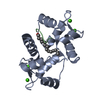
 Links
Links Assembly
Assembly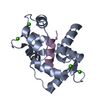
 Components
Components / CaM
/ CaM
 Homo sapiens (human) / Plasmid: pET28a / Production host:
Homo sapiens (human) / Plasmid: pET28a / Production host: 
 Escherichia coli BL21(DE3) (bacteria) / Strain (production host): BL21(DE3) / References: UniProt: P62158, UniProt: P0DP23*PLUS
Escherichia coli BL21(DE3) (bacteria) / Strain (production host): BL21(DE3) / References: UniProt: P62158, UniProt: P0DP23*PLUS Water
Water X-RAY DIFFRACTION / Number of used crystals: 1
X-RAY DIFFRACTION / Number of used crystals: 1  Sample preparation
Sample preparation
 ROTATING ANODE / Type: RIGAKU / Wavelength: 1.5418 Å
ROTATING ANODE / Type: RIGAKU / Wavelength: 1.5418 Å : 1.5418 Å / Relative weight: 1
: 1.5418 Å / Relative weight: 1  Processing
Processing :
:  MOLECULAR REPLACEMENT
MOLECULAR REPLACEMENT Movie
Movie Controller
Controller



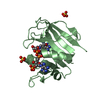
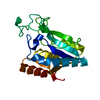
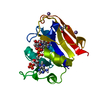
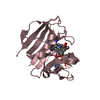
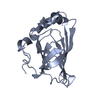
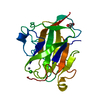
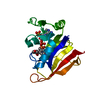
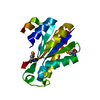
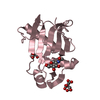

 PDBj
PDBj


































